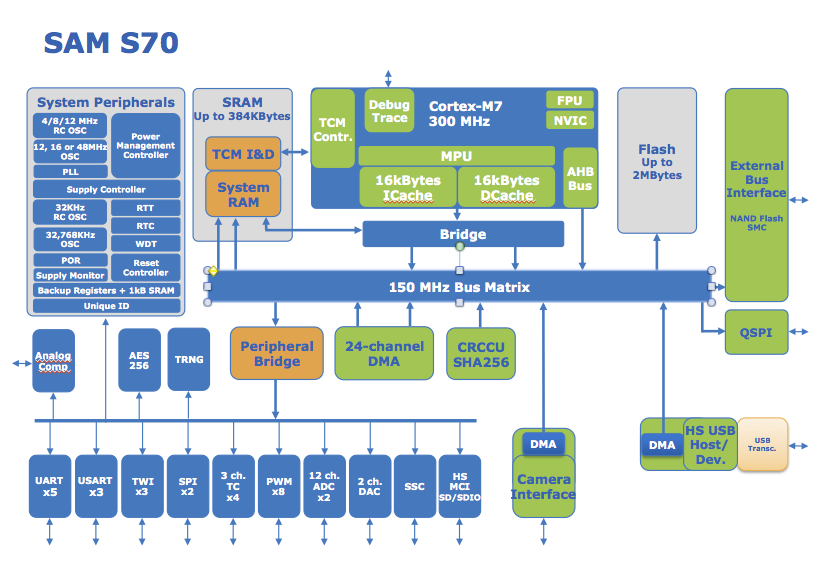Automotive apps are running in production by million units per year, and cost is a crucial factor when deciding on an integrated solution.
It’s all about Cost of Ownership (CoO) and system level integration. If you target automotive related application, like audio or video processing or control of systems (Motor control, inverter, etc.), you need to integrate strong performance capable MCU with a DSP. In fact, if you expect your system to support Audio Video Bridging (AVB) MAC on top of the targeted application and to get the automotive qualification, the ARM Cortex-M7 processor-based Atmel SAMV70/71 should be your selection: offering the fastest clock speed of his kind (300 MHz), integrating a DSP Floating Point Unit (FPU), supporting AVB and qualified for automotive.
Let’s have a closer look at the SAM V71 internal architecture, shall we?
When developing a system around a microcontroller unit, you expect this single chip to support as many peripherals as needed in your application to minimize the global cost of ownership. That’s why you can see the long list of system peripherals (top left of the block diagram). Meanwhile, the Atmel | SMART SAM V71 is dedicated to support automotive infotainment application, e.g. Dual CAN and Ethernet MAC (bottom right). If we delve deeper into these functions, we can list these supported features:
- 10/100 Mbps, IEEE1588 support
- MII (144-pin), RMII (64-, 100, 144-pin)
- 12 KB SRAM plus DMA
- AVB support with Qav & Qas HW support for Audio traffic support
- 802.3az Energy efficiency support
- Dual CAN-FD
- Up to 64 SRAM-based mailboxes
- Wake up from sleep or wake up modes on RX/TX
The automotive-qualified SAM V70 and V71 series also offers high-speed USB with integrated PHY and Media LB, which when combined with the Cortex-M7 DSP extensions, make the family ideal for infotainment connectivity and audio applications. Let’s take a look at this DSP benchmark:
If you are not limited by budget consideration and can afford integrating one standard DSP along with a MCU, you will probably select the SHARC 21489 DSP (from Analog Devices) offering the best-in-class benchmark results for FIR, Biquad and real FFT. However, such performance has a cost, not only monetarily but also in terms of power consumption and board footprint — we can call that “Cost of Ownership.” Automotive apps are running in production by million units per year, and cost is absolutely crucial in this market segment, especially when quickly deciding to go with an integrated solution.
To support audio or video infotainment application, you expect the DSP integrated in the Cortex-M7 to be “good enough” and you can see from this benchmark results that it’s the case for Biquad for example, as ARM CM7 is equal or better than any other DSP (TI C28, Blackfin 50x or 70x) except the SHARC 21489… but much cheaper! Good enough means that the SAMV70 will support automotive audio (Biquad in this case) and keep enough DSP power for Ethernet MAC (10/100 Mbps, IEEE1588) support.
In the picture above, you can see the logical SAM V71 architectures for Ethernet AVB support and how to use the DSP capabilities for Telematics Control Unit (TCU) or audio amplifier.
Integrating a DSP means that you need to develop the related DSP code. Because the DSP is tightly integrated into the ARM CM7 core, you may use the MCU development tools (and not specific DSP tools) for developing your code. Since February, the ATSAMV71-XULT (full-featured Xplained board, SAM V71 Xplained Ultra Evaluation Kit with software package drivers supporting basic drivers, software services, libraries for Atmel SAMV71, V70, E70, S70 Cortex-M7 based microcontrollers) is available from Atmel. As this board has been built around the feature-rich SAM V71, you can develop your automotive application on the same exact MCU architecture as the part going into production.

Versatility and Integrated DSP built into the ARM CM7 core allows for MCU development tools to be used instead of having to revert to specific DSP tools. You can develop your automotive application on exactly the same MCU architecture than the part going into production.
Interested? More information on this eval/dev board can found here.
This post has been republished with permission from SemiWiki.com, where Eric Esteve is a principle blogger as well as one of the four founding members of SemiWiki.com. This blog first appeared on SemiWiki on April 29, 2015.




Pingback: Atmel tightens automotive focus with new Cortex-M7 MCUs | Atmel | Bits & Pieces
Pingback: 4 designs tips for AVB in-car infotainment | Atmel | Bits & Pieces
Pingback: ARM Keil ecosystem integrates the Atmel SAM ESV7 | Atmel | Bits & Pieces